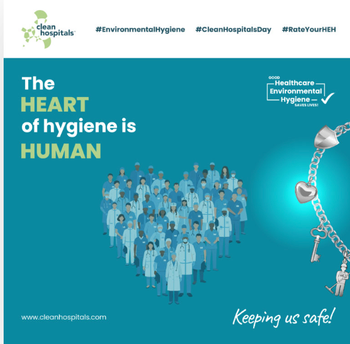
Bath Basins as a Source of Hospital-Associated Infections
Hospital-associated infections (HAIs) affect millions of patients in the United States annually, with treatment costs exceeding $6.5 billion. As mandates, legislation and changing payment structures increase pressure to eliminate HAIs, hospitals are looking more closely at possible sources of contamination. One area that hospitals are looking at is patient bath basins.
Increasing research indicates that patient bath basins are a source of bacteria and pose a threat of cross contamination. Bacteria exist in hospital water supplies and hospital staff can transmit bacteria both into and via water. In addition, reusable washcloths can spread harmful bacteria during bathing when bacteria are transferred to the basin and returned to the patient. Patients who have surgical wounds or skin breakdown are prone to acquire HAIs from bath water.
Justine OFlynn, RN, infection control liaison at Kosair Childrens Hospital in Louisville, Ky., took some time via email to discuss research she has conducted with hospital bath basins and the steps her hospital has taken to reduce organism spread, cross contamination and HAI risk.
Q: Can you provide some background information on hospital-associated infections that can help readers understand the scope of the problem?
A: The vast majority of people go into a hospital with very little concept of how easy it can be to pick up a hospital-associated, or nosocomial, infection. In fact, estimates indicate that HAIs affect up to 3.5 million U.S. patients and cause about 90,000 deaths each year. They are the fifth leading cause of death in acute-care hospitals.1-3 Although hospitals and clinicians are becoming increasingly aware and the healthcare industry has made some progress toward addressing the problem, hospital-associated infections remain a growing concern.4-6 Hospitals and clinicians need to explore all possible contaminant sources if they are to get this major cause of morbidity and mortality under control.
Q: How much of a problem is basin bathing when it comes to HAIs?
A: In general, when a person is sick enough to stay in the hospital, they have an increased risk of infection. According to recent research, hospital water supplies are likely sources for many HAIs and can lead to infections like pneumonia, bacteremia and urinary tract infections.5,7,8 Contaminated water supplies can spread infection from patient to patient.4,9-12 Hospitals take precautions, such as chlorinating, filtering or disinfecting the water and these measures can decrease water microbial counts4,5,10,13,14 but do not eliminate bacteria completely. Hospital staff members can also transmit pathogens into the water with their hands and with washcloths.15,16 In reality, mechanical friction during bathing sloughs skin flora into water, so basins can become a source for cross-contamination and serve as a potential reservoir for pathogens that lead to infections.13,15,17 The drying effect of soaps and hot water, combined with the friction of harsh, rough washcloths on skin can leave skin dry and cracked and can provide entry points for bacteria.18 Reusable bath cloths can exacerbate the problem and provide an avenue of spread from a patient to the basin and back to the patient. Studies have shown up to 100 percent of bathwater samples to be positive for bacterial growth.19 Based on my own research, I would say it is very likely that bath basins increase the potential for HAIs.
Q: Can you give some examples of the types of bugs spread through basin bathing? Are there serious symptoms or outcomes?
A: In our study, more than half of the basins were positive for organism growth. Most often, we found coagulase-negative Staphylococcus species, Bacillus species and Micrococcus species on the cultures. These bugs can cause mild to major skin infections, and can lead to things like bacteremia, pneumonia and in some cases sepsis.
Q: What can hospital staffs do to reduce the risk of spreading infection via bath basins?
A: The most obvious and simple step hospitals could take to reduce a patients exposure to these pathogens would be to find ways to help patients bathe without using a basin, because the organisms are clearly there. Harsh soaps and rough, reusable towels exacerbate the problem by sloughing skin and organisms into the water and back onto the skin, as well as by drying out the skin which can lead to cracks. If there is no bath basin, there is no risk of contamination from bath basins.
Q: Basin baths have been standard in hospitals for years. For the patient who is not able or permitted to get up and shower, what are the alternatives?
A: You are correct. Most hospitalized patients do not have shower privileges and the bath basin has indeed been the standard. One viable option would be a pre-packaged bath product, such as a cloth with a solution already on it. Some hospitals use these already. For example, one product is a gentle cloth with USP purified water, surfactants, aloe and vitamin E. Naturally, that removes the risk of contamination from the basin and any waterborne contamination risk. It also reduces environmental cross contamination and the transfer of bugs. Moreover, the material is soft and the cleanser is mild so it does not strip away the skins natural protective barrier. I would strongly recommend using a product like this in place of basin baths.
References
1. Stone PW, Braccia D, Larson E. Systematic review of economic analyses of heath care-associated infections. Am J of Infect Control. 2005;33:501-509.
2. Weinstein RA. Nosocomial infection update. Emerg Infect Dis. 1988;4:416-420.
3. CDC. Public health focus: surveillance, prevention, and control of nosocomial infections. MMWR Morb Mortal Wkly Rep.1992;41:783- 787. Available at:
4. Exner M, Kramer A, Lajoie L, et al. Prevention and control of healthcare associated waterborne infections in health care facilities. Am J Infect Control. 2005;33:S26-S40.
5. Anaissie EJ, Penzak SR, Dignani MC. The hospital water supply as a source of nosocomial infections: a plea for action. Arch Intern Med. 2002;162:1483-1492.
6. Panhotra BR, Saxena AK, Al-Mulhim AS. Contamination of patients files in intensive care units: an indication for strict handwashing after entering case notes. Am J Infect Control. 2005;33:398-401.
7. Hunter P. National disease burden due to waterborne transmission of nosocomial pathogens is substantially overestimated. Arch Intern Med. 2006; 163:1974.
8. Anaissie E. In reply: National disease burden due to waterborne transmission of nosocomial pathogens is substantially overestimated. Arch Intern Med. 2006;163:1974-1975.
9. World Health Organization. Guidelines for drinking water quality. 3rd edition. Geneva:WHO: 2004. Available at:
10. Emmersen A. Emerging waterborne infections in healthcare settings. Emerg Infect Dis. 2001;7:272-276.
11. Tercelj-Zorman M, Seljak M, Stare J, et al. A hospital outbreak of Legionella from a contaminated water supply. Arch Environ Health. 2004;59:156-159.
12. Trautmann M, Lepper PM, Haller M. Ecology of Pseudomonas aeruginosa in the intensive care unit and the evolving role of water outlets as a reservoir of the organism. Am J Infect Control. 2005;33:S41-S49.
13. Clark AP, John LD. Nosocomial infections and bath water: any cause for concern? Clin Nurse Spec. 2006; 20:119-123.
14. Sheffer P, Stout J, Wagener M, et al. Efficacy of new point of use water filter for preventing exposure to Legionella and waterborne bacteria. Am J Infect Control. 2005;33:S20-S25.
15. Sehulster L, Chinn RYW. Guidelines for environmental infection control in health-care facilities: recommendations of CDC and the Healthcare Infection Control Practices Advisory Committee (HICPAC). MMWR Morb Mortal Wkly Rep . 2003;52:1-42.
16. Larson EL, McGinley KJ, Foglia AR, et al. Composition and antimicrobic resistance of skin flora in hospitalized and healthy adults. J Clin Microbiol. 1986;23:604-608.
17. Larson EL. Comparison of traditional and disposable bed baths in critically ill patients. Am J Crit Care. 2004;13:235-241.
18. Bryant RA, Rolstad BS. Examining threats to skin integrity. Ostomy Wound Manage. 2001;47(6):18-27.
19. Shannon R, Allen M, Durbin A, et al. Patient bath water as a source of nosocomial microbiological contamination: an intervention study using chlorohexidine. J Healthcare Safety, Compliance, and Infect Control. 1999;3:180-184.
Newsletter
Stay prepared and protected with Infection Control Today's newsletter, delivering essential updates, best practices, and expert insights for infection preventionists.





